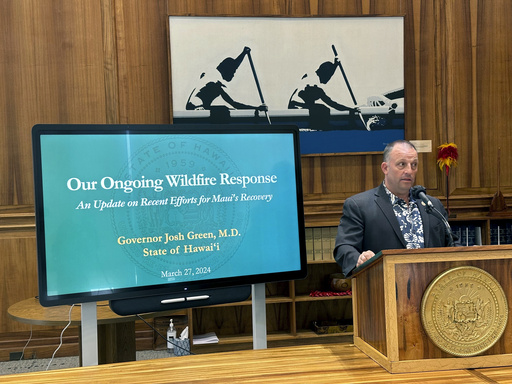HONOLULU (AP) — Hawaii Gov. Josh Green said Wednesday some 3,000 people displaced by Lahaina’s wildfires are still living in hotels more than seven months after the August blaze but that up to 30 people are moving to longer-term housing each day.
Green told a news conference the state and federal government have lined up sufficient long-term rental units to shelter everyone who is currently in one of 11 hotels still housing survivors. The state and federal governments are also building some modular transitional housing units for displaced residents. Green said he expects all displaced residents will leave the hotels by July 1.
Nearly 8,000 Lahaina residents were living in 40 hotels in the days immediately after the fire.
Maui has a severe housing shortage. In West Maui, much of the housing that does exist has been used as vacation rentals for tourists. In December, Green threatened to use the “hammer” of emergency orders to impose a moratorium on Maui short-term rentals if enough property owners didn’t make their units available to Lahaina residents.
But Green said Wednesday such a moratorium won’t be necessary. He said the state has contracts for 1,300 units and that the number of households in hotels has dropped to under 1,300.
One issue now, Green said, is that many available rentals are not in West Maui, and some Lahaina residents have refused them because they want to stay near their jobs and their children’s schools.
“A lot of people have been offered an apartment, housing, and have rejected it because it’s too far away from West Maui, or it didn’t suit their family circumstance,” Green said.
Green said people are being given four opportunities to accept housing that is offered and two chances to appeal an option provided. He said some people have rejected housing four, five and even six times. Green said authorities are trying to be understanding because they don’t want to disrupt people’s lives even further but that people will need to leave the hotels eventually.
“Once that transitional housing comes online, honestly, people will have to go move into those if they haven’t left the hotels yet because it’s only fair,” Green said. “We need the resources so that we can build the next school, so that we can rebuild clinics that were lost during the fire.”
Jordan Ruidas, a founder and organizer of the Lahaina Strong community group, expressed disappointment that Green didn’t impose a moratorium.
“Today Governor Green chose the comfort of short-term vacation rental owners over the needs of thousands of fire survivors,” Ruidas said in a text message. She said Green was “turning away” from his responsibility and authority to use his executive powers to prohibit vacation rentals in West Maui.
Green said in his news conference that he has asked his attorney general to “get serious” about enforcing laws against illegally operated short-term rentals. Ruidas said she looked forward to hearing how the attorney general will do that.
Using the Hawaiian word for land, Ruidas said Lahaina Strong hopes the planned crackdown occurs “before more families leave the aina and communities many have called home for generations.”
The fire destroyed 3,971 properties and caused $4 billion to $6 billion in property damage.
Of these properties, 561 were occupied by homeowners. One-quarter of these lots have already been cleared of debris, Green said.
“That means they’re going to get permits sometime later this year to begin to rebuild back in Lahaina,” Green said, while acknowledging water, sewer and electricity service will need to be restored to these lots.


